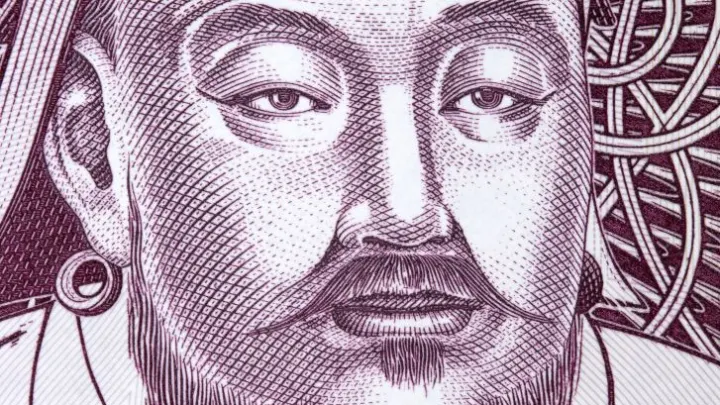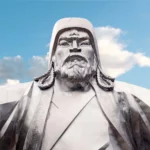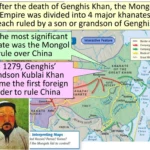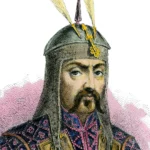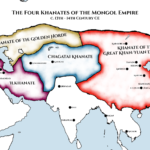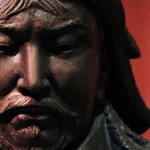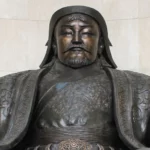Get ready for a wild ride back in time with Genghis Khan, the bad boy of ancient history! From his humble beginnings as just another dude on the steppe to becoming the boss of the biggest empire the world had ever seen, Genghis Khan’s story is full of crazy battles, smart strategies, and a whole lot of conquest. He wasn’t just a war machine, though; he also knew how to make friends and influence people. So sit back, relax, and let’s dive into the epic tale of Genghis Khan, the man who made history bow down.
Genghis Khan’s Epic Story: From Humble Beginnings to Global Conqueror
In the vast steppes of Mongolia, a boy named Temüjin embarked on an extraordinary journey that would transform the world forever. Born into poverty and adversity, Temüjin overcame countless challenges to become the legendary Genghis Khan, a name that still strikes awe into the hearts of historians and everyday people alike.
Early Struggles and Tribal Unification
Temüjin’s early life was a roller coaster of hardship and triumph. When his father was killed in a raid, he and his family were cast into the wilderness. However, fate had a different plan in store for him. With unyielding determination, Temüjin returned to his tribe and gradually united the nomadic clans of Mongolia, forming a formidable force under his rule.
Conquests and Empire Building
With a loyal army at his command, Genghis Khan unleashed a wave of conquests that swept across vast territories. His tactics were as innovative as they were deadly. He employed lightning-fast cavalry charges, meticulous siege warfare, and a ruthless scorched earth strategy, leaving his enemies shattered in his wake. By 1227, the Mongol Empire had reached its zenith, stretching from the glittering spires of China to the far-flung reaches of Eastern Europe.
Legacy and Impact
Genghis Khan’s legacy is a complex tapestry of both triumph and tragedy. His conquests brought about political turmoil, cultural exchange, and economic growth, but they also left a trail of destruction and displacement. Yet, beneath his ruthless exterior lay a visionary leader who promoted religious tolerance, established a legal framework, and encouraged trade.
Beyond his battlefield triumphs, Genghis Khan’s empire paved the way for the rise of the Mongol Yuan dynasty in China. His descendants continued to rule vast territories in Asia for centuries after his death, cementing his legacy as one of the most influential and enigmatic figures in human history.
Key Dates in Genghis Khan’s Life:
| Event | Date |
|---|---|
| Birth of Temüjin | 1162 |
| Unification of Mongolian tribes | 1206 |
| Coronation as Genghis Khan | 1206 |
| Death of Genghis Khan | 1227 |
Pros and Cons of Genghis Khan’s Rule:
Pros:
- United a vast region under a single authority, promoting political stability
- Facilitated cultural exchange and trade, fostering connections between different civilizations
- Established a legal system and administrative structure, creating order and governance
Cons:
- Waged ruthless campaigns of conquest, resulting in destruction and displacement
- Imposed strict and often brutal punishments on those who opposed his rule
- Oversaw a scorched earth policy in some territories
Discover the history of Genghis Khan, the legendary conqueror who established the largest contiguous empire in history. Explore his empire and the innovative military tactics that made him invincible. Delve into his legacy and the lasting impact he had on the world.
Military Campaigns and Conquests
Genghis Khan’s military prowess played a pivotal role in forging the Mongol Empire. His savvy tactics and ruthless strategies left an indelible mark on history.
Unveiling the Secrets of Mongol Dominance:
- Methodical and Disciplined Army: The Mongol army, like a well-oiled machine, operated with precision and discipline. Their mastery of cavalry maneuvers, archery, and siege warfare gave them an edge on the battlefield.
- Centralized Control: Genghis Khan, the supreme commander, wielded absolute authority over his military, ensuring flawless coordination and lightning-fast decision-making.
- Psychological Masterstrokes: Beyond sheer force, Khan employed terror and intimidation to shatter enemy morale, softening them up for defeat.
- Embracing Expertise: He understood the importance of skilled professionals, incorporating them into his ranks while ruthlessly crushing potential threats.
- Unparalleled Conquest: Genghis Khan’s military conquests stretched far and wide, from the vast expanse of China to the grandeur of Persia, shaping one of the largest empires the world had ever witnessed.
Conquest Chronicles of the Xi Xia Kingdom and Jin Dynasty:
In 1205, Khan’s forces descended upon the Xi Xia Kingdom, their disciplined assault culminating in the surrender of the capital, Yinchuan. The kingdom became another jewel in the crown of the Mongol Empire.
Khan’s thirst for conquest continued with his invasion of the Jin Dynasty in 1211. In a daring siege, the Mongols stormed the capital, Zhongdu, only to face treachery when the emperor reneged on an agreement, leading to the brutal sacking of the city.
Confronting the Khwarezm Empire:
Genghis Khan’s most ambitious military undertaking was his conquest of the Khwarezm Empire. From 1219 onwards, the Mongols embarked on a relentless campaign, sweeping through Central Asia and Persia, vanquishing vast territories and leaving a trail of destruction in their wake.
Historical Footnote:
As we delve into the annals of history, Genghis Khan’s legacy as a military mastermind continues to inspire awe and trepidation. His strategies and tactics have been studied and admired by military leaders throughout the ages, leaving an enduring imprint on the art of warfare.
Establishment and Administration of the Mongol Empire: An Empire Built on Ingenuity and Organization
The Mongol Empire, a colossal force that swept across Asia in the 13th century, wasn’t just a powerhouse on the battlefield. Its secret weapon lay in the brilliant leadership and administration of Genghis Khan and his successors.
Creating a Meritocratic Empire
Genghis Khan was a master at recognizing talent and loyalty. He rewarded skilled individuals from conquered territories, regardless of their background. This meritocratic approach ensured that the administration was filled with the best and brightest minds, paving the way for a well-functioning empire.
Centralized Control with Checks and Balances
While the Great Khan held absolute authority, he didn’t rule alone. Decisions were made through discussions with trusted advisors and military commanders. This balance of power prevented any one person from becoming too powerful and kept the administration in check.
Law and Order: The Yassa Code
The Mongols enforced a strict legal code called the Yassa, which covered every aspect of life. From military discipline to trade practices, the Yassa created order and stability in the vast empire. By enforcing these laws, the Mongols ensured a sense of fairness and predictability throughout their territories.
Religious Tolerance: A Unifying Force
While Genghis Khan himself followed a unique blend of shamanism and ancestor worship, he allowed freedom of religion for his subjects. This policy of tolerance fostered harmony among the diverse populations of the empire. Different faiths coexisted peacefully, contributing to the overall stability and unity of the Mongol Empire.
Communication and Trade: Connecting the Empire
The Mongols established an impressive network of roads and postal stations, which allowed for efficient communication and trade. Armies, goods, and information could travel vast distances quickly, keeping the empire connected and facilitating economic growth. This infrastructure was essential for maintaining control over such a vast territory.
The Legacy of Mongol Administration
The Mongol Empire’s administrative system was revolutionary for its time and left a lasting impact on the world:
- Uniting Eurasia: The empire connected East and West, fostering cultural exchange, trade, and the spread of ideas. This interconnectedness created a foundation for future global interactions.
- Economic Prosperity: The secure trade routes and integration of conquered territories led to economic growth and prosperity. The Mongols promoted trade, encouraged innovation, and facilitated the exchange of goods across different regions.
- Cultural Diffusion: The Mongol Empire became a conduit for cultural exchange. Ideas, technologies, and artistic styles traveled great distances, enriching the cultures of both the Mongols and their subjects. This cross-pollination left a lasting impact on world history.
- Legacy of Tolerance: The Mongol Empire’s policy of religious tolerance set an example for future empires. It fostered a spirit of coexistence and mutual respect among people of different faiths, contributing to the harmony and stability of the vast empire.
In summary, the Mongol Empire’s success was not only due to its military prowess but also its exceptional administrative skills. The meritocratic system, centralized authority with checks and balances, strict laws, religious tolerance, and efficient communications laid the foundation for a vast, stable, and prosperous empire that left a lasting legacy on the world.
Diplomatic Approaches and Communication: The Art of Expansion and Diplomacy
In the vast and untamed steppes of Central Asia, Genghis Khan emerged as a formidable conqueror known not only for his military prowess but also for his astute diplomatic skills. By embracing diplomacy as a powerful tool, he expanded his empire, forged alliances, and established trade relationships that extended the Mongol influence across vast territories.
Diplomatic Strategies of Genghis Khan
- Diplomatic Missions:Genghis Khan established diplomatic missions in Persia, China, and even distant Europe. These missions were the nerve centers of negotiations, trade agreements, and intelligence gathering. By sending envoys to foreign courts, Khan aimed to build diplomatic connections, understand the political landscape, and lay the groundwork for future alliances.
- Communication and Cultural Exchange:Khan recognized the significance of communication and cultural exchange. He encouraged his commanders to learn foreign languages and customs to facilitate understanding. He welcomed scholars, artisans, and merchants from distant lands, creating a vibrant hub where knowledge and ideas flowed freely. This cross-cultural pollination enriched both the Mongol Empire and the nations they encountered.
- Alliances and Conflict Avoidance:Khan understood the power of alliances and prioritized building diplomatic ties with neighboring states. By forming alliances, he secured his borders, gained access to resources, and averted unnecessary conflicts. Even when faced with enemies, he was willing to seek negotiations to preserve lives and resources, a testament to his pragmatic approach.
- Trade and Cultural Exchange:Khan encouraged trade as a means of fostering economic growth and strengthening diplomatic relations. He established trade routes that connected his empire with distant lands, promoting the exchange of goods, ideas, and technologies. This vibrant trade network not only expanded the Mongol Empire’s wealth but also disseminated their culture and practices, leaving a lasting impact on the interconnected world.
- System of Envoys:To maintain effective communication across his vast empire, Khan established a system of envoys who traveled regularly to his court. These envoys carried messages, reports, and diplomatic correspondence, ensuring a constant flow of information. By keeping abreast of developments throughout his territory, Khan could make informed decisions and maintain control over his sprawling empire.
Key Benefits of Diplomatic Approaches
| Benefit | Impact |
|---|---|
| Negotiation of Treaties | Secured alliances and trade agreements |
| Enhanced Communication | Fostered understanding and cultural exchange |
| Alliances and Conflict Avoidance | Strengthened borders and preserved resources |
| Trade and Cultural Exchange | Promoted economic growth and knowledge dissemination |
| Envoys and Communication System | Facilitated the smooth flow of information and maintained control over vast territories |
Conclusion
Genghis Khan’s diplomatic approaches and communication strategies played a pivotal role in the expansion and consolidation of his vast empire. By embracing diplomacy as a potent tool, he established a network of alliances, facilitated trade, and fostered cultural exchange. His pragmatic and skillful approach to diplomacy left a lasting legacy, shaping the political and cultural landscape of the Eurasian continent.
- Unlock Water’s Symbolism: A Cross-Cultural Exploration - April 20, 2025
- Identify Black and White Snakes: Venomous or Harmless? - April 20, 2025
- Unlocking Potential: Origins High School’s NYC Story - April 20, 2025
